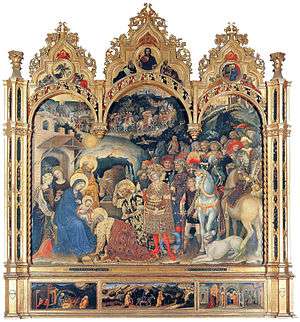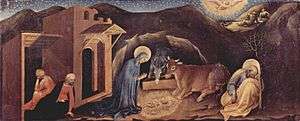Adoration of the Magi (Gentile da Fabriano)
 | |
| Artist | Gentile da Fabriano |
|---|---|
| Year | 1423 |
| Medium | Tempera on panel |
| Dimensions | 203 cm × 282 cm (80 in × 111 in) |
| Location | Uffizi Gallery, Florence |
The Adoration of the Magi is a painting by the Italian painter Gentile da Fabriano. The work, housed in the Uffizi Gallery in Florence, Italy, is considered his finest work, and has been described as "the culminating work of International Gothic painting".[1]
The painting was commissioned by the Florentine literate and patron of the arts Palla Strozzi, at the arrival of the artist in the city in 1420. Palla paid 300 florins for the altarpiece,[2] or about six times the annual salary of a skilled labourer.[3] According to Baldwin[4] both Palla Strozzi and his father, Onofrio, appear in the painting − Palla as the man in the red hat in the forefront of the painting, and Onofrio as the falcon trainer situated behind the youngest king. According to other opinions, the falcon trainer depicts the commissioner Palla Strozzi with his eldest son Lorenzo to his right.[5][6] Finished in 1423, the painting was placed in the new chapel of the church of Santa Trinita which Lorenzo Ghiberti was executing in these years.



The works shows both the international and Sienese schools' influences on Gentile's art, combined with the Renaissance novelties he knew in Florence. The panel portrays the path of the three Magi, in several scenes which start from the upper left corner (the voyage and the entrance into Bethlehem) and continue clockwise, to the larger meeting with the Virgin Mary and the newborn Jesus which occupies the lowest part of the picture. All the figures wear splendid Renaissance costumes, brocades richly decorated with real gold and precious stones inserted in the panel. Gentile's typical attention for detail is also evident in the exotic animals, such as a leopard, a dromedary, some apes and a lion, as well as the magnificent horses and a hound.
The frame is also a work of art, characterized by three cusps with tondoes portraying Christ Blessing (centre) and the Annunciation (with the Archangel Gabriel on the left and the Madonna on the right). The predella has three rectangular paintings with scenes of Jesus' childhood: the Nativity, the Flight into Egypt and the Presentation at the Temple (the latter a copy, the original being in the Louvre in Paris).
References
- ↑ Timothy Hyman; Sienese Painting, p. 140, Thames & Hudson, 2003 ISBN 0-500-20372-5.
- ↑ Mary Hollingsworth; "Patronage in Renaissance Italy: From 1400 to the Early Sixteenth Century", p. 41, John Murray, 1994 ISBN 0719549264.
- ↑ Niccolo Capponi; "An Unlikely Prince: The Life and Times of Machiavelli", p. 9, Da Capo Press, 2010 ISBN 9780306817564.
- ↑ Baldwin, Robert (2007). "GENTILE DA FABRIANO (c. 1390-1427): International Style and Court Culture" (PDF). Social History of Art, by Robert Baldwin.
- ↑ Palazzo Strozzi (pdf;1,39 MB)
- ↑ Ingeborg Walter, Die Strozzi: Eine Familie im Florenz der Renaissance, Beck Munic 2011, p. 27
External links
| Wikimedia Commons has media related to Adorazione dei Magi by Gentile da Fabriano. |